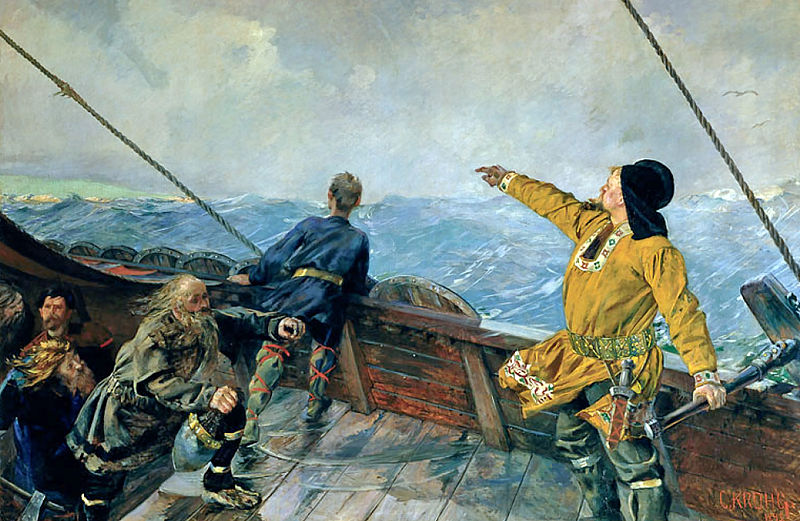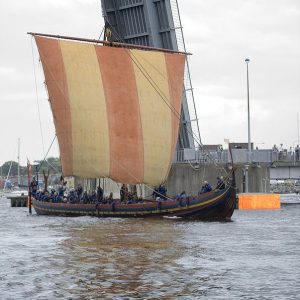The Vikings were Norse pirates who used advanced technology to travel the world, pillaging and expanding their territory during what is known as the Viking Age. Vikings came from three countries Denmark, Norway, and Sweden. At the time people from these countries who went out raiding were said to be “going Viking”. Not all Vikings were violent, some settled down into peaceful jobs, but some were warriors, who pillaged and slaughtered as a way of life. Some civilisations were shocked to find thousands of Vikings invading their lands out of nowhwere. This is a list of the 10 most savage Viking voyages of all time.
Ireland

The Vikings raided Ireland extensively and sacked many towns, but also founded many as well. Dublin, Ireland’s capital was founded by Vikings, also Limerick, Wexford, Waterford, Wicklow, Arklow, and Leixlip. In 795 Vikings started by pillaging Irish monasteries, and then spread out from there. At first it was small scale raids committed by small groups of Vikings, but after 830 they started coming in large fleets, sometimes with over 100 ships in total. These invasions culminated around 200 years later, at the Battle of Clontarf. The high king of Ireland fought against the Vikings at Dublin. The battle was hard fought, and both sides had respect for the other, but in the end the Irish managed to defeat the Vikings, under King Silkbeard of Dublin, and kick them out of the country.
Viking Voyages Into Iceland

Vikings first arrived in Iceland around 860 ad. Garder the Swede set out in the year 260 on a voyage from Denmark to Scotland. While he crossed the cold ocean, a powerful storm blew him off course. Garder had no idea where he might end up. He found himself in an icy mountainous land he didn’t recognise. This was Iceland. Garder began exploring, and after looking over the whole terrain, he found it was an island. He went back home and told everyone about this new land he discovered. More people began exploring the island, and started going there. Due to the secluded nature of the island, it was the perfect hideout. Two brothers (Ingolf, and Hjorleif) saw the island as the perfect place to escape the debts they owe to the Jarl, however travel wasn’t cheap.
To fund the expedition they took a detour to Ireland, stole resources and kidnapped 10 slaves. The two brothers split up once they reached the island. Hjorleif settled in a spot he thought was good. Whereas Ingolf let the gods decide. He did this by throwing his seat pillars overboard and settling wherever it landed. It took three years to find it. Hjorleif was slaughtered by his own slaves, who then fled. When Ingolf found his body, he was saddened, and went to seek revenge. The slaves had moved to some nearby islands which became known as The Isles of the Irish. Ingolf took them by surprise, and killed most of them, the rest jumped off a cliff in a panic, and died that way. Ingolf eventually found the pillar he threw off the ship, and founded his settlement there, which still lasts to this day.
Viking Voyages Into Greenland
Eric the Red left Iceland, but not by choice. He had been exiled for murder in 982. Three years after the exile, he stumbled upon Greenland, but didn’t stay for long. Eric evidently never managed to get the mysterious island off his mind, and set sail with 25 Viking ships to form a settlement on the island. The journey was tumultuous and one by one his ships started to disappear, until they only had 14 left. These 14 eventually managed to reach Greenland. Here they set up two settlements both of which did fairly well at first, and altogether their populations might have grown to whole 5,000 people. However, they weren’t the only inhabitants.
The Skraelings also lived on the island. They were natives to it, and didn’t take to the Vikings. Skraeling raided one of the settlements, and attacked the people there. This coincided with a change in climate, which made it near impossible to grow crops, and with people dying of starvation, or being killed by Skraelings, the two colonies eventually just disappeared.

Viking Voyages Into Normandy

In the 9th century Vikings began making violent incursions into the territory of the Frankish Empire. This is when they first started appearing in Normandy. The Vikings sacked many major towns, and the Empire was left with no choice but to try and buy the Vikings off. They offered gold and silver to the Vikings, and the incursions stopped, but only temporarily. Vikings then came back and began to pillage the empire even more. Eventually they conquered the territory completely, and the Viking leader Rollo became it’s Duke. The name Normandy comes from these Vikings. At first it was known as “Nothmannia” which means “Land of the Norseman”.
Italy

viciarg ᚨ / (CC BY-SA 3.0)
Vikings raided the city of Luni in Italy and sacked it. They were led by Hastein and Bjorn Ironside. They went on to sack Pisa and Fiesole. Vikings didn’t just travel down to Italy for raids, but sometimes would also work as mercenaries. They were used to fight against the Arabs in 936. Later these mercenaries worked for Harald Hardrada who conquered Sicily in 1040.

Viking Voyage To Constantinople

In 860 Rus’ Vikings besieged Constantinople in response to the Byzantine Empire building the fortress Sarkel. This fortress restricted Rus’ trade routes. The siege lasted seven years but nobody is exactly sure who won. The Vikings did have some successful raids on the outskirts of Constantinople. Eventually they left, but it isn’t clear whether this was due to them losing or not. The Vikings had a large fleet of 200 ships. When they arrived, they began burning homes, stabbing residents, and destroying monasteries. The attack was so surprising that it was described as being “like a thunderbolt from heaven”.
Viking Voyages Into Islamic Iberia
Vikings travelled down to the Iberian Penninsula, which was ruled by Muslims at the time, and began raiding the area for plunder and women. Vikings invaded Al-Andalus in 844 and went on to raid, and capture other areas as well. They were eventually forced out by a Muslim counterattack. The Vikings then started looting and raiding other areas. They occupied Sevilla for 42 days before being defeated by the Arabs.
In 860 the Vikings returned with a giant fleet of 66 ships, led by Hastein and Bjorn Ironside. They attacked Northwestern Spain, Portugal, Sevilla, and made their way to North Africa to sack Nekor. In 969 the Norman Jarl Gundraed decided to put on an invasion of Islamic Iberia like no other. He organised 100 ships, and 8,000 warriors. They spent years in the Iberian Peninsula and captured the major city Santiago de Compstela which is now the capital of Galicia. Count Gonzalo Sanchez eventually managed to force them out in 971.
Islamic Levant
Runestones found in Scandinavia reveal the Viking Voyages into Arabia and Central Asia. The family members of Vikings who died in Serkland (Arabia) are the ones who erected the runestones. Harald Hardrada was a Viking King, who sent the Vikings to Palestine, North Africa, Sicily, and Armenia.
West Francia And Middle Francia

The worst Viking raids of Francia took place during the rule of Charles the Bald. In order to counteract these raids he constructed fortified bridges and created an army that would be ready to respond whenever Vikings invaded. The Vikings joined the fray of a civil war taking place in the area and allied with Peping II, who was rivals with Charles the Bald. The Vikings perpetrated raid after raid, year after year during the Civil war. Viking treasure has been found by archaeologists in the area.
Viking Voyages Into England
Three Viking ships landed on English shores in the late 8th century. They were met by a man who innocently assumed they were traders, and tried to give them directions. The Vikings slaughtered him and went on to plunder the local area. The earliest recorded Viking raid in England was in 793 when they robbed a monastery on the island of Lindisfarne. They kept raiding England, and terrorising the locals, until they one day were met with a much larger army than they expected. This army killed them and all their leaders.
The surviving Vikings tried to escape, but only made it to Tynemouth, where they were killed by the local residents. The Vikings didn’t raid England for about 40 years after this. This period ended with the Great Heathen Army, led by Ivar the Boneless. They landed in England in 865, and went on to capture York. This led to a lot of violent warfare, causing thousands of deaths. Multiple other armies came to raid England after this point until they finally stopped in 1085.













